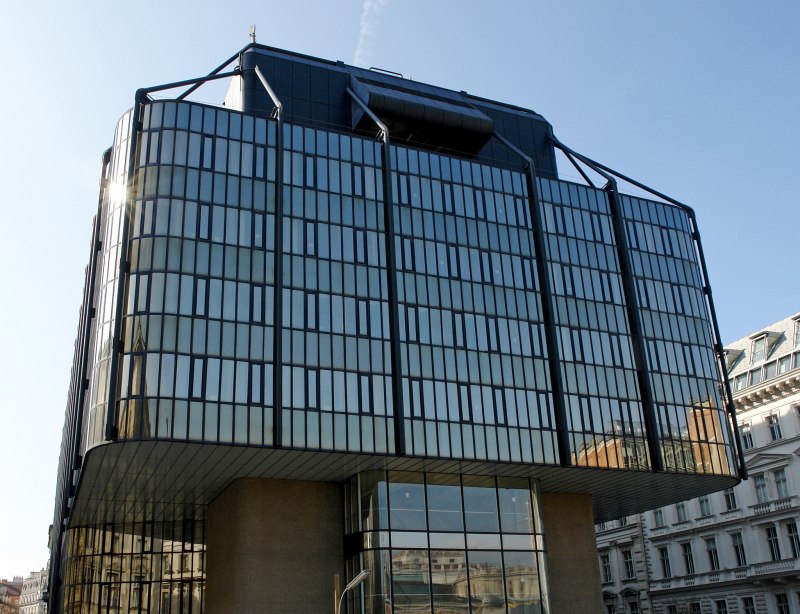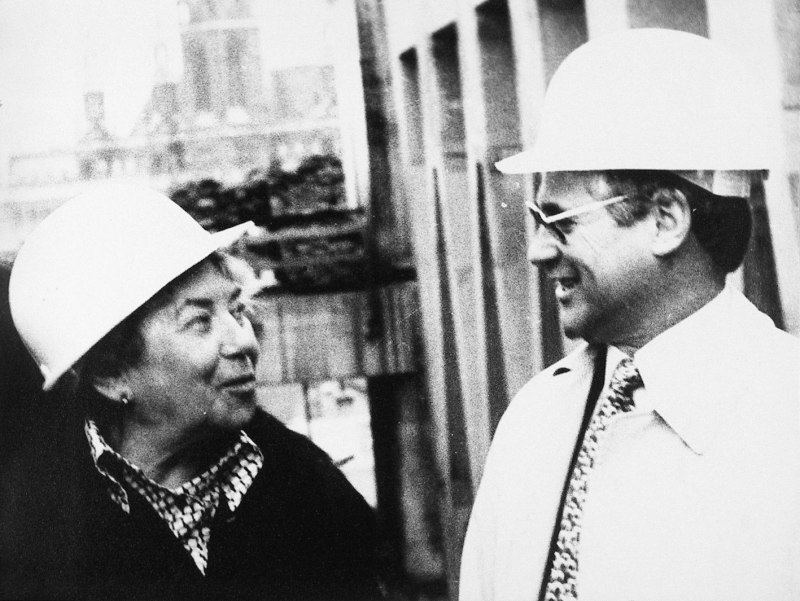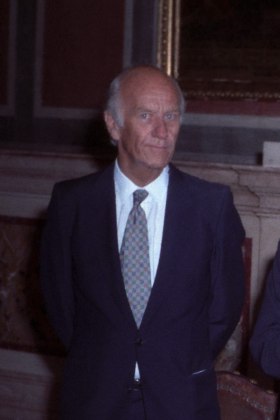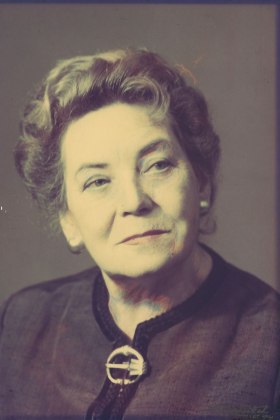Juridicum
100 years after the main building at the Ringstraße was opened in 1884, the Faculty of Law moved to the “Juridicum”. Since 1984 numerous institutes have been housed in the central building of the Faculty of Law (at the time still the Faculty of Law and Economics), with the library in the center, a lecture center on the lower floor and an event location on the top floor. Architect Ernst Hiesmayr began designing and planning the building in 1968.
Acute lack of space
In the beginning of the 1960s the university had a severe problem with space. The Purr study of 1965 on the university’s urban space development possibilities described the situation of the Faculty of Law as follows: “The space situation must almost be called catastrophic. Professors, lecturers and students must often work in a single room; the lecture halls, institutes and seminars cannot take in any more students. The acute lack of space endangers a dignified education for the students. Research activities at the university are made nearly impossible for the teachers under these circumstances.” Purr argued for an inner city expansion instead of a larger campus on the outskirts and recommended an independent faculty building.
Construction site in the Ringstraße neighborhood
In 1968 the Ministry of Education bought a building complex from the tire company Semperit that was located about 5 walking minutes from the main building, between Helferstorferstraße and Schottenbastei 10-16. The other faculties rejected the derelict buildings as unsuitable, whereupon the Faculty of Law and Economics claimed them for a construction project to help them solve their space issues. After drawing up floor and function plans it was decided to tear down the old building complex (about 11,000m2) and to construct a new building for the legal disciplines. In 1970 the demolition of the Semperit complex was begun. One of the challenges for the design of the new building was to accommodate 22,000m2 of usable space on a building footprint of only 2,600m2, without towering over the neighboring buildings or building more than three floors underground due to ground water concerns.
Modern architecture
Architect Ernst Hiesmayr began planning the Juridicum in 1969/70 together with Prof. Günther Winkler, the building commissioner of the Faculty of Law (construction 1974-1984). The plans especially caused a stir because of the future building’s suspended bridge construction: the 26 meters tall house does not “stand”, but instead the floors are hanging from an about 30 meters tall double bridge with a span of almost 53 meters. This steel frame weighs almost 3,000 tons and rests on four 39 meters tall massive ferroconcrete pylons, which also house a cooling system which would prevent the snapping of these supporting elements in case of a fire. This made thick supporting walls unnecessary and thus created the required floor space and enabled the large, completely pillar-free entrance hall. The steel-glass façade in the historic surroundings was met with criticism by the neighbors in the buildings on the Ringstraße.
More space for students
The new house offered five times as much usable space as before, with almost 85% of the space being dedicated to the library and teaching and common rooms for students. The dean’s office and the Österreichische HochschülerInnenschaft (Austrian Students’ Union) also moved in, and the administration of the faculty and the library were simplified and concentrated. All working spaces are divided in a relatively egalitarian fashion between the various groups of people, and particularly in their furnishing they manifest a rather democratic understanding of architecture as well as of the university itself. Next to traditional mass lecture halls are rooms for smaller didactical concepts, as well as a café and a large recreational hall (“Aula”), with a generous pedestrian zone rounding out the plans in front of the building (the first legally dedicated one in Vienna).
Quickly too small again
In the 1960s the number of teachers and students rose at the Faculty of Law and Economics, while the Universitätsorganisationsgesetz (University Organisation Law, UOG) of 1975 and the Study Law for Jurists from 1978 created new parameters during the construction phase (more professorial chairs, increase in academic personnel), noticeable beginning in the 1980s. At the start of the planning phase there were 1,800 law students and the number was expected to rise to triple that in 15 years. However, the increase was in fact much larger, while the personnel also grew by about 30 to 40 percent more than had been accounted for. The book stock also increased more than the expected growth from 120,000 to 360,000 books. Despite quadrupling the available space – earlier the faculty had had about 4,000m2 of usable space in the main building and about 1,000m2 in other rented buildings – the first plans for a further extension and expansion towards the Schottenbastei high school were already made when the building was opened; the house opposite the Juridicum in the Heßgasse was also rented.
Library in the center
The library is located at the center of the building. It was established exclusively for scientific use in the late 19th century from the estates of the two famous jurists Heinrich Siegel and Anton Menger (“Juridic Seminar”, later “Main Institute of Law”, then “Library of Law”). Apart from this, students had access to the self-administrated so-called “Proseminar”-Library, which was incorporated into the main library after the Second World War. An increase in the book stocks as well as in the number of student library users and the foundation of new institutes and chairs in 1962 already led to a division of the library – spatially, budget-wise and in regard to administration, followed by further segmentation. As part of the University Organization Law of 1975, the library was recentralized, incorporated into the University Library and established as the Faculty Library for Law dedicated to the whole faculty in 1977. Architecturally and organizationally, the open access library founded in 1984 and spanning six floors forms the center of the Juridicum, Here, while selecting reading material, teachers and students can democratically meet one another and can communicate with each other.
Furthermore, the building also contains magazine and depot rooms, a garage with 70 parking spaces on the third basement floor and a shelter for 1,100 people.
Remembrance of the National Socialist period
After the end of the Austrian victim myth in Kurt Waldheim’s election campaign in 1986 and the memorial year of 1988 on the occasion of the 50th anniversary of the so-called “Anschluss”, the atmosphere of departure in the course of the move led to a more open and systematic examination of the faculty’s own past. This manifested itself in various ways, such as a lecture series on “National Socialism and Law”, as well as a memorial plaque in the lecture hall area of the Juridicum, which was unveiled in March 1988. The bronze plaque commemorates those “that resisted the abuse of the law to oppress and exterminate human beings”.
“Kunst am Bau”
Several valuable sculptures can be found in the generous pedestrian area in front of the Juridicum, erected as part of the “Kunst am Bau” (“Art in Construction”) project. These include a bronze sculpture by Herbert Albrecht and a lying stone sculpture by Karl Prantl at Helferstorferstraße, as well as two large-sized works by Max Weiler (“Natur mit Caput Mortuum” and “Ganz rechts lebendige Natur”, 1973) on the girder floor, and the blue-green “glass cloud” by Leo Wollner on the top floor.
In 2004 the Juridicum attained literary honors, when it became a crime scene in a crime novel (Inge Gampl, “Tod im Juridicum”) as well as being featured in Klub Zwei’s documentary film “Liebe Geschichte” in 2009.
Zuletzt aktualisiert am : 18.09.2024 - 11:49












